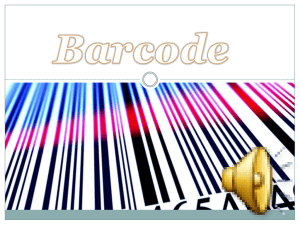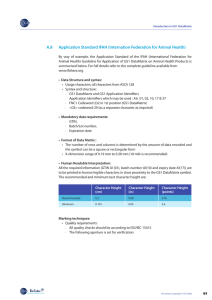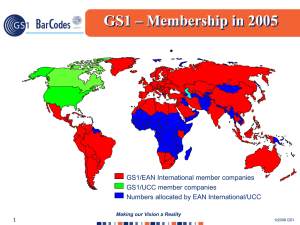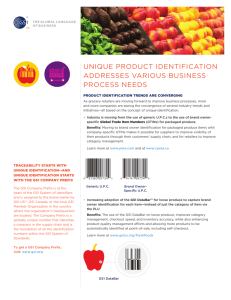Ten steps to GS1 barcode implementation
advertisement
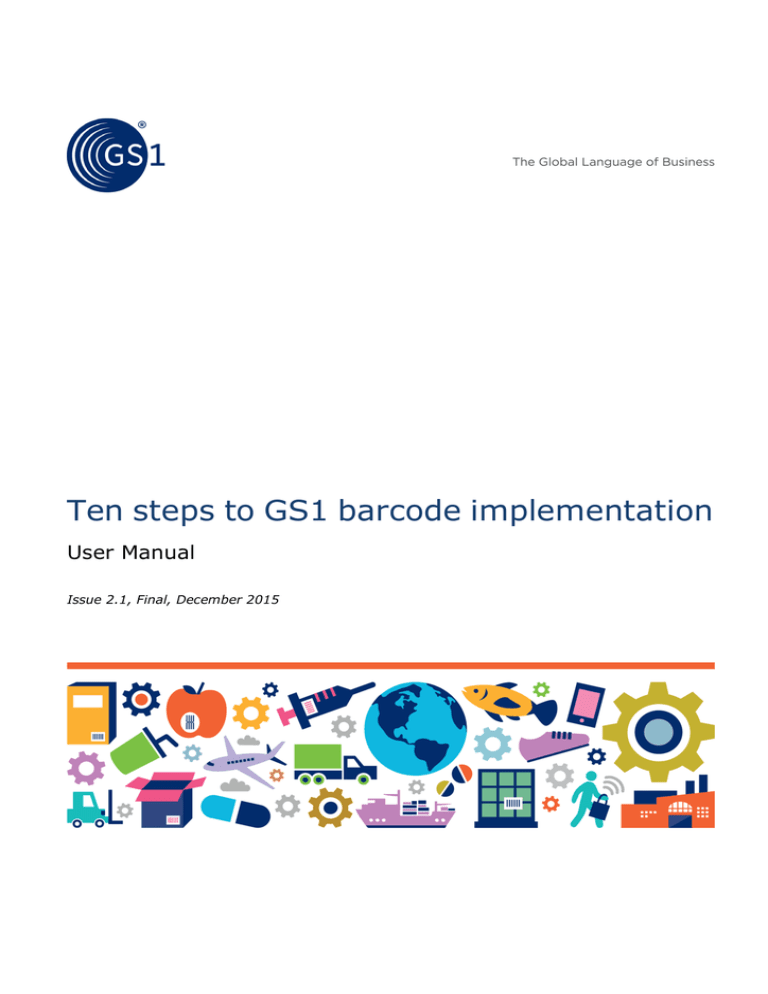
Ten steps to GS1 barcode implementation User Manual Issue 2.1, Final, December 2015 Ten steps to GS1 barcode implementation User Manual Document Summary Document Item Current Value Document Title Ten steps to GS1 barcode implementation User Manual Date Last Modified December 2015 Document Issue Issue 2.1 Document Status Final Log of Changes in Issue 2.1 Issue No. Date of Change Changed By Summary of Change 2 16 January 2015 Coen Janssen Major updates to content and graphics. 2.1 10 December 2015 Coen Janssen Updated step 3 Disclaimer THIS DOCUMENT IS PROVIDED “AS IS” WITH NO WARRANTIES WHATSOEVER, INCLUDING ANY WARRANTY OF MERCHANTABILITY, NONINFRINGMENT, FITNESS FOR PARTICULAR PURPOSE, OR ANY WARRANTY OTHER WISE ARISING OUT OF THIS SPECIFICATION. GS1 disclaims all liability for any damages arising from use or misuse of this Standard, whether special, indirect, consequential, or compensatory damages, and including liability for infringement of any intellectual property rights, relating to use of information in or reliance upon this document. GS1 retains the right to make changes to this document at any time, without notice. GS1 makes no warranty for the use of this document and assumes no responsibility for any errors which may appear in the document, nor does it make a commitment to update the information contained herein. Issue 2.1, Final, December 2015 All contents copyright © GS1 Page 2 of 12 Ten steps to GS1 barcode implementation User Manual I ntroduction The most important implementation resource for barcode identification are the over 100 GS1 Member Organisations in countries all around the world. This guide takes new barcode users through the basic steps they must take to begin using barcodes. Ten Steps to Barcode Implementation Step 1 Get a GS1 Company Prefix Step 2 Assign numbers Step 3 Select a barcode printing process Step 4 Select a "primary" scanning environment Step 5 Select a barcode Step 6 Pick a barcode size Step 7 Format the barcode text Step 8 Pick a barcode colour Step 9 Pick the barcode placement Step 10 Build a barcode quality plan Issue 2.1, Final, December 2015 All contents copyright © GS1 Page 3 of 12 Ten steps to GS1 barcode implementation User Manual 1 Get a GS1 Company Prefix Before a company can begin using barcodes, they must first assign the numbers that go inside the barcode, called GS1 Identification Keys. The first step in assigning a GS1 Identification Key is to obtain a GS1 Company Prefix from a GS1 Member Organisation. The GS1 Company Prefix provides a way for companies to create identification keys for trade items, logistic units, locations, parties, assets, coupons, etc. which are unique all around the world. GS1 Company Prefixes are used by 1.3 million companies worldwide as the basis for creating unique numbers to identify everything in the supply chain. 2 Assign numbers After receiving a GS1 Company Prefix, a company is ready to begin assigning identification numbers to their trade items (products or services), themselves (as a legal entity), locations, logistic units, individual company assets, returnable assets (pallets, kegs, tubs), and/or service relationships. The process is simple. Your local GS1 Member Organisation can provide you with specific information about how many numbers you can assign based on the length of your GS1 Company Prefix. See the GS1 Identification Keys – Executive Summaries for short introductions on the role and characteristics for each of the GS1 keys. Issue 2.1, Final, December 2015 All contents copyright © GS1 Page 4 of 12 Ten steps to GS1 barcode implementation User Manual 3 Select a barcode printing process To begin, you should decide what you are barcoding and if the barcode will carry static or dynamic information inside it. Printing Methods If the information is static (always the same), the barcode can be printed using traditional printing presses directly on the package (e.g., paper milk carton) or on a label that is applied to the package (e.g., label on a gallon milk jug.) If the information is dynamic then either digital or a combination of digital and traditional printing will be required. Traditional • Flexography • Offset Digital • • Thermal Laser Direct Marking E.g. etching, engraving For example: If the product requires multi-colour graphics and a barcode with dynamic data, the graphics could be pre-printed using traditional printing presses and leave a blank portion of the label for digital printing inline during production and packaging. If the product only requires text and a barcode with dynamic data, a label could be printed inline and applied to the package (automatically if high volume or by hand if low volume). It could also be printed directly on the package itself without using a label. Also a barcode with static data could be printed directly on the package using a digital printing method, for example when the same packaging is used for different products. Your local GS1 Member Organisation is there to assist you in making the right selection, and many Member Organisations can also help you find a printing company in your local area. 4 Select a "primary" scanning environment Scanning Environments The specifications for barcode type, size, placement, and quality all depend on where the barcode will be scanned. By knowing where your barcode will be scanned you can establish the right specifications for its production. Barcodes to be scanned at the retail point-of-sale will need to support omnidirectional scanning. • Point-of-sale (POS) • General Logistics • Healthcare Items • Direct Part Marking Distribution and If the barcode will be scanned at point-of-sale as well as in the warehouse, you will need to use a symbol that accommodates point-of-sale scanning, but printed in a larger size to accommodate scanning in the distribution process. Barcodes on healthcare items to be scanned in hospitals and pharmacies do not require omnidirectional scanning, unless the items are also scanned at retail point-of-sale. Issue 2.1, Final, December 2015 All contents copyright © GS1 Page 5 of 12 Ten steps to GS1 barcode implementation User Manual 5 Select a barcode Selecting the right barcode is critical to the success of your barcode implementation plan, but here are some high level tips: ■ If you need to barcode a trade item that will be scanned at the retail point-of-sale (POS), first symbol of choice is the EAN/UPC symbol. This symbol is guaranteed to be scanned by POS systems all over the world. In some cases GS1 DataBar symbol may be applied. ■ If you are printing a barcode with variable information like serial numbers, expiry dates, or measures, then you will use GS1-128, GS1 DataBar, or GS1 2D symbols. ■ If you want to encode a URL into a barcode to make extended packaging information available to the end consumer, then you should use a GS1 2D symbol. ■ If you need to barcode an outer case to be scanned in a logistics environment, and you want to print directly on corrugated carton, ITF-14 may be the choice for you. There are other factors to consider so contact your local GS1 Member Organisation to see what implementation products and services they offer. The GS1 Barcodes GS1 EAN/UPC Family UPC-A EAN-13 GS1 2D Barcodes UPC-E EAN-8 GS1 QR Code GS1 DataMatrix GS1 DataBar Family Omnidirectional Expanded Stacked Expanded Stacked Omnidirectional Truncated Limited Stacked GS1 1D Symbols used in General Distribution and Logistics but not at retail POS GS1-128 ITF-14 See the GS1 Barcode Fact Sheets for an overview of the key characteristics for each of the GS1 barcodes. Issue 2.1, Final, December 2015 All contents copyright © GS1 Page 6 of 12 Ten steps to GS1 barcode implementation User Manual 6 Pick a barcode size After the correct barcode symbol is specified together with the information to encode in it, the design stage begins. The size of the symbol within the design will depend on the symbol specified, where the symbol will be used, and how the symbol will be printed. Symbol sizes The X-dimension is the specified width of the narrowest element of a barcode. X-dimensions are used together with the symbol heights to specify the permissible symbol sizes. For each scanning environment the relevant symbols are listed with their target X-dimension and corresponding target height. Besides the target sizes also the allowed minimum and maximum sizes are specified. Example: UPC Symbol Sizes Minimum X-dimension 0.264 mm ; 0.0104” Target X-dimension 0.330 mm ; 0.0130” Maximum X-dimension 0.660 mm ; 0.0260” Minimum symbol height 18.28 mm ; 0.720” Minimum symbol height 22.85 mm ; 0.900” Minimum symbol height 45.70 mm ; 1.800” EAN/UPC symbols EAN/UPC Symbols are designed for scanning by retail omnidirectional scanners. This means that EAN/UPC Symbols have two segments which are taller than they are wide. There is a fixed relationship between symbol height and width. When one dimension is modified, the other dimension should be altered by a proportional amount. Omnidirectional EAN/UPC symbols are suitable for omnidirectional scanning since they can be read from all directions by a fixed scanner. In order to decrease the amount of space EAN/UPC Symbols take up on a design, a decreased symbol height might be specified. This process, called truncation, is not permitted within EAN/UPC symbology specifications and should be avoided. This is because of the negative impact it has on scan rates for retail omnidirectional scanners. Issue 2.1, Final, December 2015 All contents copyright © GS1 Page 7 of 12 Ten steps to GS1 barcode implementation User Manual Consideration of the printing process The final major consideration for symbol size is the capability of the selected printing process. The minimum size (magnification) and correct Bar Width Reduction (BWR) for a symbol varies by printing process and even from press to press. Printing companies should establish a minimum symbol size (magnification) and BWR to achieve acceptable and repeatable quality results. See GS1 General Specifications, “GS1 System Symbol Specification Tables” in section 5 for information on the allowed sizes of all GS1 Symbols based on the application where they are used. Symbol Specification Table 1 provides the details for the retail point-of-sale scanning environment. 7 Format the barcode text The text beneath a barcode, called Human Readable Interpretation (HRI), is important because if the barcode is damaged or of poor quality to begin with, then the text is used as a back-up. Here are some of the most frequently asked questions on HRI: Does the Human Readable Interpretation need to be a certain size? The human-readable text must be clearly legible and in a size proportional to the symbol size. Is the Human Readable Interpretation supposed to be above or below the symbol? HRI should be placed below the barcode and grouped together wherever physically possible while maintaining the HRI legibility and minimum barcode height. I see parentheses around the Application Identifiers (AI) under some barcode symbols. Are they supposed to be there and are they encoded in the bars and spaces of the symbol? All AIs must be enclosed in parentheses in the Human Readable Interpretation, but the parentheses are not encoded in the symbol. How many digits do I print beneath the EAN/UPC Symbol in the Human Readable text? ■ You must print 12 digits below the UPC-A Symbol. ■ You must print 13 digits below the EAN-13 Symbol. ■ You must print eight digits below UPC-E and EAN-8 Symbols. See the GS1 Human Readable Interpretation (HRI) Implementation Guide for more information. Issue 2.1, Final, December 2015 All contents copyright © GS1 Page 8 of 12 Ten steps to GS1 barcode implementation User Manual 8 Pick a barcode colour The optimum colour combination for a barcode symbol is black bars with a white background. If you want to use other colours, the following may help you in choosing satisfactory ones: ■ GS1 barcodes require dark colours for bars (e.g., black, dark blue, dark brown, or dark green). ■ The bars should always consist of a single line colour and should never be printed by multiple imaging tools (e.g., plate, screen, cylinder, etc.). Barcode colour examples ■ GS1 barcodes require light backgrounds for the Quiet Zones (area free of printing around the barcode) and spaces (e.g., white). ■ In addition to light backgrounds, "reddish" colours may also be used. If you have ever been in a darkroom with red lighting and tried to read red copy, you know it can virtually disappear. This is also true of similar colours such as orange, pink, peach, and light yellows. Given the fact that most barcode scanners use a red light source, you can quickly see why these colours may be suitable for backgrounds, but should be avoided for bars. ■ In many cases the symbol background is not printed and the colour of the packaging substrate is used as barcode background. However, if the symbol background is printed beneath the bars, the background should be printed as solid line colours. ■ If you use multiple layers of ink to increase the background opacity, each layer should be printed as a solid colour. ■ If you use a fine screen to deliver more ink to the substrate, be sure there are no voids in the print caused by the screen not adequately filling in. As explained, black bars and white spaces are the optimal combination, but other colour combinations can be used. Consult an experienced printing company recommended by your GS1 Member Organisation for additional guidance. Issue 2.1, Final, December 2015 All contents copyright © GS1 Page 9 of 12 Ten steps to GS1 barcode implementation User Manual 9 Pick the barcode placement When discussing symbol location we are referring to the symbol placement on the design. When assigning symbol placement first the packaging process should be considered. You should consult the packaging engineer to make sure the symbol will not be obscured or damaged (e.g., over a carton edge, beneath a carton fold, beneath a package flap, or covered by another packaging layer). After determining the proper placement, the printing company should be consulted. This is because many printing processes require barcodes to be printed in a specific orientation to the feed direction of the web or sheet. When using flexographic printing the bars should run parallel to the press direction. If the bars are required to run perpendicular to the press direction check to ensure the symbol is not distorted. When using either silk screen or rotogravure printing processes, the symbol should be aligned parallel to the cell structure on the screen or gravure plate cylinder to provide the smoothest bar edge possible. To determine the proper location for GS1 barcodes, see the following topics in section 6 of the GS1 General Specifications: • General Placement Principles • General Placement Guidelines for the Retail Point of Sale • Placement Guidelines for Specific Package Types • Symbol Placement for Clothing and Fashion Accessories • General Placement Guidelines for Symbol Placement on Items used in Distribution • Clothing and Fashion Accessories Label Design, Logistics Label Design Issue 2.1, Final, December 2015 All contents copyright © GS1 Page 10 of 12 Ten steps to GS1 barcode implementation User Manual 10 Build a barcode quality plan ISO/IEC 15416 Barcode Print Quality Test Specifications for Linear Symbols describes a method for assessing the quality of barcode symbols after they are printed. An ISO-based verifier looks at the symbol in the way a scanner does, but goes further by grading the symbol's quality. GS1 utilises the ISO/IEC method, but specifies the minimum grade necessary for every GS1 barcode based on which symbol is used, where it is used, or what identification number it is carrying. In addition to the minimum grade, GS1 also specifies the verifier aperture width and wavelength. Setting up different minimum specifications is similar to a university using a standardised test to determine whether applicants qualify for admission. Several universities may utilise the same standardised test, but each sets the minimum score necessary for its applicants to be admitted. GS1 General Specifications, section 5, provides a quick reference list of symbol quality specifications depending on the symbol type, the application, and the GS1 identification key the symbol is carrying. GS1 Members may choose to perform their own quality control of barcode production. Today, many GS1 Member Organisations offer barcode quality verification services. Issue 2.1, Final, December 2015 All contents copyright © GS1 Page 11 of 12 Ten steps to GS1 barcode implementation User Manual L inks Documentation ■ GS1 General Specifications: The GS1 Standard that describes how GS1 barcodes and identification keys should be used: http://www.gs1.org/genspecs ■ GS1 GTIN Allocation Rules: This standard provides specific rules on GTIN allocation that apply to prevalent industry practices for the Fast Moving Consumer Goods (FMCG) industry: http://www.gs1.org/1/gtinrules/ ■ GS1 Identification Keys: One page summaries for each of the GS1 Identification Keys: http://www.gs1.org/id-keys ■ GS1 Barcodes: One pages summaries of all GS1 barcodes, including an overview of printing methods and scanning environments: http://www.gs1.org/barcodes ■ GS1 Industries: Information on the way GS1 standards are applied in various sectors. http://www.gs1.org/industries Contact Find your local GS1 Member Organisation: http://www.gs1.org/contact Issue 2.1, Final, December 2015 All contents copyright © GS1 Page 12 of 12
